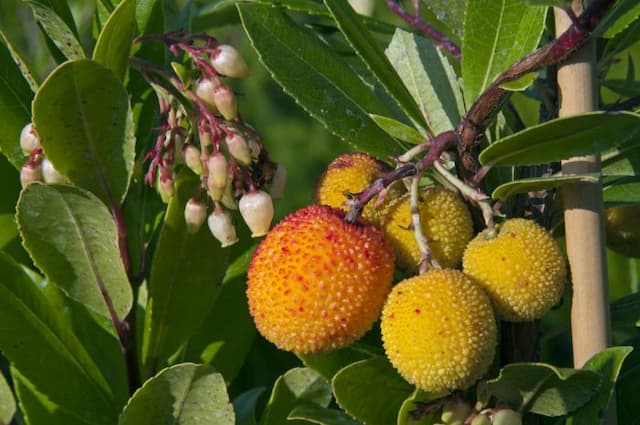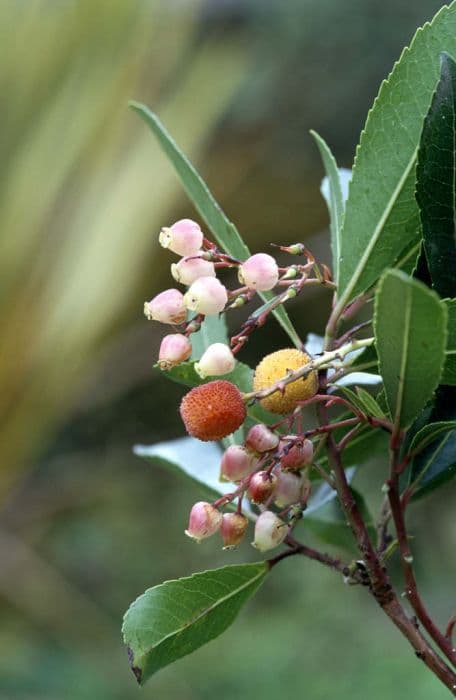Azalea Rhododendron luteum (A)

ABOUT
Rhododendron luteum, commonly known as the yellow azalea, is a deciduous shrub known for its highly fragrant flowers. It is adorned with funnel-shaped blooms that possess a striking yellow color, which release a pleasant perfume into the surrounding air during springtime. These vivid flowers cluster at the ends of branches, forming conspicuous groups that attract various pollinators. The leaves of the yellow azalea are equally distinctive, emerging as a fresh green in spring, with a slightly shiny appearance, and then transforming in autumn to a vibrant array of yellows, oranges, and reds before falling off. These leaves are elongated and have a somewhat glossy texture, with a smooth edge. Furthermore, the bark of the yellow azalea provides a subtle contrast to its bright flowers and foliage. It has a relatively smooth texture with a brownish hue that supports the framework of the plant. Overall, the yellow azalea offers a feast for the senses with its aromatic flowers, eye-catching floral display, and the dynamic seasonal color change of its leaves.
About this plant
 Names
NamesFamily
Ericaceae
Synonyms
Yellow Azalea, Honeysuckle Azalea, Pontic Azalea, Yellow Rhododendron
Common names
Azalea pontica, Rhododendron flavum, Rhododendron ponticum var. luteum.
 Characteristics
CharacteristicsLife cycle
Perennials
Foliage type
Deciduous
Color of leaves
Green
Flower color
Yellow
Height
5 feet (1.5 meters)
Spread
7 feet (2.1 meters)
Plant type
Shrub
Hardiness zones
5
Native area
Europe
Benefits
 General Benefits
General Benefits- Aesthetic Appeal: Rhododendron luteum, commonly known as Azalea, has vibrant yellow flowers that enhance the beauty of gardens and landscapes.
- Habitat for Wildlife: The plant provides shelter and breeding grounds for various species of birds and insects.
- Pollinator Attraction: Azaleas attract bees, butterflies, and other pollinating insects, supporting local ecosystems.
- Soil Erosion Control: The root system helps stabilize soil and prevent erosion, especially on slopes.
- Culture and Heritage: Azaleas have cultural significance in many societies and are often featured in gardens and festivals.
- Shade Tolerance: This species can thrive in partially shaded environments, making it versatile for different garden designs.
- Seasonal Interest: With its spring blooms and sometimes colorful autumn foliage, it provides visual interest across multiple seasons.
 Medical Properties
Medical Properties- Antirheumatic - historically used in folk medicine to treat rheumatism.
- Antispasmodic - may relieve spasm of involuntary muscles.
- Sedative - has been used to produce a calming effect and reduce anxiety.
 Air-purifying Qualities
Air-purifying QualitiesThis plant is not specifically known for air purifying qualities.
 Other Uses
Other Uses- Insect Repellent: The strong fragrance of A can deter certain insects, making it beneficial for planting around outdoor seating areas to reduce the presence of pests.
- Dye Production: The flowers of A contain natural pigments that have been historically used to create yellow to greenish dyes for fabrics and wool.
- Honey Plant: A is a good source of nectar, the flowers can attract bees and the plant is sometimes used in honey production for a distinctive flavor.
- Ornamental Use: With its showy, fragrant flowers, A is widely planted in gardens, parks, and cemeteries for aesthetic purposes.
- Literary and Artistic Inspiration: Due to its beauty, A has been featured in various works of poetry, literature, and visual art as a symbol of nature’s splendor.
- Cultural Significance: In some cultures, A has symbolic meanings and is used in traditional ceremonies or festivals to represent various themes like caution or territorial markers due to its toxic nature.
- Fragrance Extraction: The scent of A's flowers can be used in the production of perfumes or aromatic oils, albeit not commonly because of the potential toxicity.
- Culinary Decoration: While the plant is toxic and not typically used in cooking, the bright flowers can occasionally be used as decorative, non-edible garnishes in haute cuisine.
- Education and Research: A is used in botanical studies for educational purposes to teach about plant biochemistry, especially concerning plants that produce toxins.
- Photography and Filmmaking: The aesthetic value of A makes it a sought-after subject for photographers and filmmakers, especially during its blooming period.
Interesting Facts
 Feng Shui
Feng ShuiAzalea is not used in Feng Shui practice.
 Zodiac Sign Compitability
Zodiac Sign CompitabilityAzalea is not used in astrology practice.
 Plant Symbolism
Plant Symbolism- Beware: Rhododendron luteum, commonly known as the Yellow Azalea, is often associated with caution due to its toxic nature, reminding one to be wary of hidden dangers.
- Abundance: With its lush, full blooms, the Yellow Azalea can symbolize abundance and wealth.
- Taking care of oneself: Given its toxicity and the need for careful handling, the Yellow Azalea can represent the importance of self-care and personal boundaries.
- Elegance and dignity: The vibrant yet sophisticated appearance of the Yellow Azalea often stands for elegance and maintaining one's dignity in various situations.
- Rebirth: As a plant that blooms in spring, the Yellow Azalea can signify rebirth or a new beginning, implying transformation or a fresh start.
- Temperance: The Yellow Azalea might also symbolize temperance, suggesting a life lived in balance and moderation, inspired by the delicate nature of its flowers.
 Water
WaterAzaleas, including Rhododendron luteum, require consistent moisture and should be watered deeply about once a week, depending on weather conditions. During periods of drought or extreme heat, it may be necessary to water more frequently, ensuring that the soil remains moist but not waterlogged. Apply roughly one inch of water to the root zone each time, which is equivalent to about 0.623 gallons per square foot. Overhead watering should be avoided to reduce the risk of fungal diseases; instead, direct the water to the base of the plant. During the winter, watering can be reduced but should not be neglected, especially if the weather is dry.
 Light
LightAzaleas thrive in dappled sunlight; therefore, the ideal spot for Rhododendron luteum is in an area that receives filtered light or partial shade. While they can tolerate morning sun, they should be protected from intense afternoon rays to prevent leaf scorch. A location under the canopy of deciduous trees often creates the perfect light conditions for these plants by providing shade during the hottest part of the day while allowing some sunlight through.
 Temperature
TemperatureAzaleas like Rhododendron luteum fare best in temperatures ranging between 50°F and 70°F. They can survive in temperatures as low as 20°F and as high as 80°F, but extremes outside these limits can cause damage. The ideal growing conditions for azaleas are in US Department of Agriculture hardiness zones 5 through 8, where the winter cold isn't too severe and summer temperatures aren't excessively high.
 Pruning
PruningPruning azaleas is primarily done to maintain shape and encourage bushier growth. For Rhododendron luteum, the best time to prune is immediately after the flowers have faded in spring. Lightly trim back the branches that have just finished blooming, as this will help stimulate the growth of new shoots that can produce blooms the following year. Pruning should be done annually but can be skipped if the azalea is maintaining a good shape naturally.
 Cleaning
CleaningAs needed
 Soil
SoilAzaleas require acidic soil with a pH of 4.5 to 6.0, high in organic matter. A mix of 50% pine bark, 25% perlite, and 25% peat moss is recommended for the best growth.
 Repotting
RepottingAzaleas, being slow-growers, generally need repotting every 2 to 3 years. They should be repotted when the roots circle the pot or when growth seems to slow.
 Humidity & Misting
Humidity & MistingAzaleas thrive in moderate to high humidity levels, ideally around 50-60%. They benefit from a pebble tray or humidifier to maintain proper humidity.
 Suitable locations
Suitable locationsIndoor
Ensure bright, indirect light, and maintain high humidity.
Outdoor
Plant in partial shade with shelter from strong winds.
Hardiness zone
5-8 USDA
 Life cycle
Life cycleRhododendron luteum, commonly known as the Azalea or Yellow Azalea, begins its life as a seed, typically germinating in well-drained, acidic soil with partial shade. After germination, it enters the seedling stage where it develops its root system and first true leaves. As it grows into a young plant, it forms a woody stem and additional leaves, preparing the plant for photosynthesis and eventual flowering. The Azalea reaches maturity in several years when it begins to produce distinctive fragrant yellow flowers in spring, attracting pollinators crucial for sexual reproduction. Following pollination, the flowers develop into seed capsules, which upon ripening, release seeds, completing the reproductive cycle. Throughout its life, the Azalea undergoes seasonal cycles of growth and dormancy, with leaves often turning to attractive reddish hues in autumn before falling off as winter approaches in colder climates.
 Propogation
PropogationPropogation time
Spring to summer
The most popular method of propagating Rhododendron luteum, also known as Azalea pontica, is through semi-hardwood cuttings. This technique is generally done in late summer. New growth that is not yet firm or woody is selected as cutting material, with sections typically measuring about 4 to 6 inches (approximately 10 to 15 centimeters) long. The leaves on the lower half of the cuttings are removed, and the cut end is often dipped into a rooting hormone to enhance root development. Then, the cuttings are placed in a well-draining potting mix, ensuring the potting medium remains evenly moist but not waterlogged. They are kept under high humidity conditions which can be created by covering the cuttings with a plastic bag or placing them in a misting chamber if available. Root establishment can take several months, after which the young plants can be gradually acclimatized to less humid conditions before being planted out.









